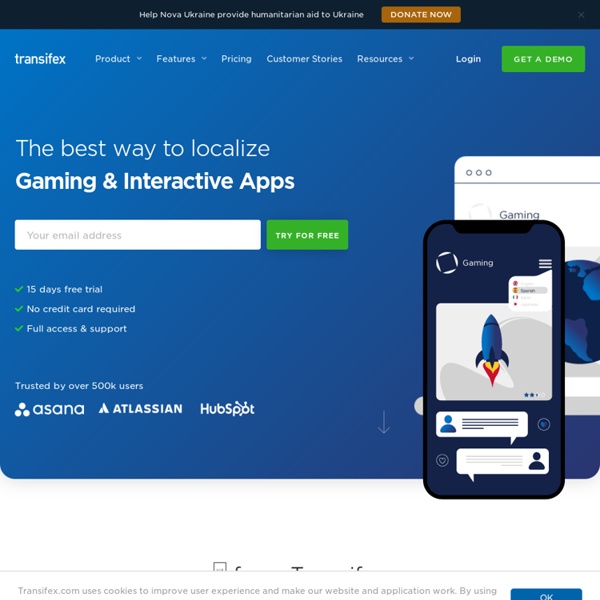



Zanata: Community powered translation Video chat with up to nine friends - Google+ About – Transifex README.rst Transifex: Localization, Evolved. "Translation workflow and crowdsourcing for agile teams and smart translators." What is Transifex? Transifex is a modern localization platform. It's an online, cloud-based, highly scalable translation management and workflow tool, with a focus to integrate well with the existing workflow of agile development teams and translators. The name comes from latin and means 'Translation artisan'. Key features: Workflow Management: Full control over your localization process. More than 25 localization formats are supported including Gettext, Java, HTML, XML, iOS, Ruby, RESX, PHP and XLIFF. Public instance: Development pages: Documentation:
a Place for Translators, Interpreters, Voice Talents, Other Language Professionals and Their Clients. websites A list of every #innovation #collaboration #CMS #ideamanagement Pretty ambitious title! The batch of Web 2.0 tools available to help companies embrace the concept of Enterprise 2.0 is myriad. As I’ve reviewed the various offerings I noted it was difficult to find a comprehensive list. So this is my attempt at assembling a definitive list of tools in this space. This list includes several sub groups: Innovation Systems, Innovation Consultants, Collaborative Platforms, Idea Management Tools, Content Management Systems, Community Building Systems, and Mind Mapping. For instance, Cognistreamer is a wonderful open innovation system and collaboration platform. March 10, 2010 update. March 23, 2010 update. May 13, 2010 update. My goal is to have a comprehensive list and not to make judgments or express preferences. At the end of this very long list is a bunch of links to others who have attempted similar lists. My apologies if I made any errors. Innovation, Collaboration, Idea Management is a very exciting milieu for corporations. R. C.F.I.
Translations for Progress: Useful Links GTS Free Translation Services - Website provides free translation between over 30 languages, and free web page translation from English into four Western languages with the possibility of online post-editing. WorldLingo Website Translator - To provide multilingual content on a website. The WorldLingo Website Translator service can help to broaden exposure by providing a fast and economical way to translate your website content in up to 32 languages. Kanji Files - It can be quite helpful for Japanese-English translators to have some Kanji lists to remind them the meaning of a Kanji or how to read it. Русско-английский словарь и языковой портал - bab.la is a free collaborative English-Russian dicitonary with hundreds of thousands of translations, synonyms, grammar, voice output, regional and colloquial expressions. www.rae.es - The official dictionary of the Real Academia Española. www.pons.de - German <-> English, Polish, Latin, Italian, Spanish, and more
collaboration The Maker Generation in the Enterprise A few days ago, I spent some time with James Powell at the Thomson Reuters offices on Times Square. It was just the kind of conversation I enjoy: we covered a lot of ground in a relatively short time, rarely had to explain anything to each other while we went off on tangents and random walks, yet kept largely to subjects of mutual interest. One of the key topics that came up was that of consumerisation. illustration courtesy of Idiots’ Books I couldn’t get the topic out of my mind as I boarded the plane back from New York to London, and I guess this post is the result of those mullings over.Things I’ve perceived while observing the Maker Generation, things that I feel will become important in tomorrow’s enterprise. Image courtesy of Stephane Guegan For much of my life, my attitude to post-facto regulation has been somewhat Oliver Hardy-ish, a sense of “here’s another nice mess you’ve gotten me into“. 1. 2. 3. 4. 5. Albert Einstein at the age of four. Exciting times. We won’t.
naati.com A rubric is a descriptive marking scheme used to determine the level of performance a candidate displays in a certification test. It is presented as a matrix that provides scaled levels of performance (or bands) for each assessment criteria. The bands describe the different levels of attainment for each performance criteria. In combination, the bands are used to determine whether the candidate has been successful or unsuccessful in a test. NAATI uses ‘task-specific rubrics’ meaning that each rubric is designed to assess a specific certification test task. The use of rubrics to assess certification test tasks was specifically recommended by the INT Report to help ensure a valid and reliable certification system. Trained examiners use the rubric to rate the performance of a candidate across a range of criteria. The rubrics designed for assessing the certification tasks have five bands with Band 1 representing the highest level of performance and Band 5 the lowest.